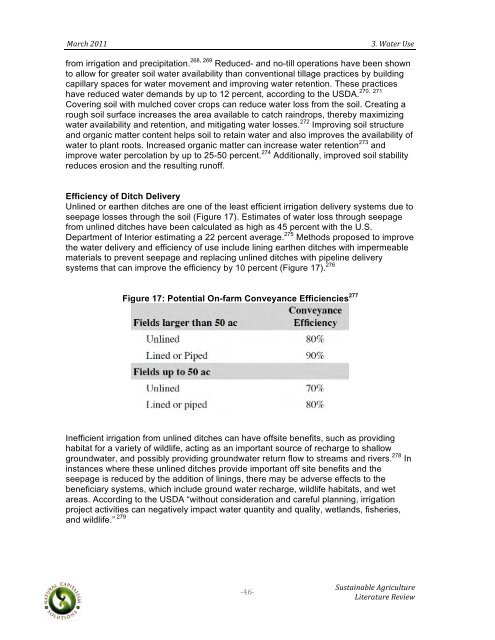Sustainable Agriculture Literature Review - Boulder County
Sustainable Agriculture Literature Review - Boulder County
Sustainable Agriculture Literature Review - Boulder County
Create successful ePaper yourself
Turn your PDF publications into a flip-book with our unique Google optimized e-Paper software.
! !!<br />
"#$%&!'())!! !!!!!!!!!!!!!!!!!!!!!!!!!!!!!!!!!!!!!!!!!!!!!!!!!!!!!!!!!!!!!!!!!!!!!!!!!?=!@#-2$!A,2!<br />
from irrigation and precipitation. 268, 269 Reduced- and no-till operations have been shown<br />
to allow for greater soil water availability than conventional tillage practices by building<br />
capillary spaces for water movement and improving water retention. These practices<br />
have reduced water demands by up to 12 percent, according to the USDA.<br />
!<br />
"%'"<br />
270, 271<br />
Covering soil with mulched cover crops can reduce water loss from the soil. Creating a<br />
rough soil surface increases the area available to catch raindrops, thereby maximizing<br />
water availability and retention, and mitigating water losses. 272 Improving soil structure<br />
and organic matter content helps soil to retain water and also improves the availability of<br />
water to plant roots. Increased organic matter can increase water retention 273 and<br />
improve water percolation by up to 25-50 percent. 274 Additionally, improved soil stability<br />
reduces erosion and the resulting runoff.<br />
Efficiency of Ditch Delivery<br />
Unlined or earthen ditches are one of the least efficient irrigation delivery systems due to<br />
seepage losses through the soil (Figure 17). Estimates of water loss through seepage<br />
from unlined ditches have been calculated as high as 45 percent with the U.S.<br />
Department of Interior estimating a 22 percent average. 275 Methods proposed to improve<br />
the water delivery and efficiency of use include lining earthen ditches with impermeable<br />
materials to prevent seepage and replacing unlined ditches with pipeline delivery<br />
systems that can improve the efficiency by 10 percent (Figure 17). 276<br />
Figure 17: Potential On-farm Conveyance Efficiencies 277<br />
Inefficient irrigation from unlined ditches can have offsite benefits, such as providing<br />
habitat for a variety of wildlife, acting as an important source of recharge to shallow<br />
groundwater, and possibly providing groundwater return flow to streams and rivers. 278 In<br />
instances where these unlined ditches provide important off site benefits and the<br />
seepage is reduced by the addition of linings, there may be adverse effects to the<br />
beneficiary systems, which include ground water recharge, wildlife habitats, and wet<br />
areas. According to the USDA “without consideration and careful planning, irrigation<br />
project activities can negatively impact water quantity and quality, wetlands, fisheries,<br />
and wildlife.” 279<br />
!*+,-#./#012!34$.%+1-+$2!<br />
5.-2$#-+$2!627.28!
















